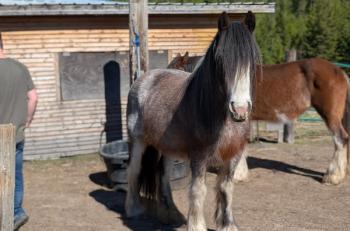
Uncovering the gray areas of EPM
Certain areas have seen cluster outbreaks of this disease and helped shed light on risk factors and preventive measures.
Although equine protozoal myeloencephalitis (EPM) has been actively researched during the past decade, definitive scientific knowledge of this disease remains as elusive as the opossums that transmit it. In almost all aspects of this disease—from pathogenesis and diagnosis to treatment and prevention—gray areas remain.
THINKSTOCK
That said, some risk factors and prevention strategies have been unveiled. Good news, right? Unfortunately, much of the information that's been discovered about EPM has served only to generate more questions, and many practitioners feel less knowledgeable about this disease now than they did five years ago.
Clinical signs of severe or advanced EPM are relatively straightforward and easy to see, including asymmetrical muscle loss, varying degrees of weakness and ataxia and even recumbency. Evidence of early, low-level EPM, however, can be so insignificant or subtle that it's often overlooked. Practitioners often depend on clients noticing small physical changes in their horses [musculature, posture, gait and impulsion] or minor unexplained changes in personality or behavior (Photo 1, p 2). Additionally, signs of EPM can mimic those of several other neurologic diseases or health conditions.
Moreover, methods of EPM diagnosis have been shown to be problematic and often inconclusive, so clinicians are often left using a "better safe than sorry" strategy—that is, when in doubt, assume its EPM. This means some unaffected horses may also be treated, and other conditions may be missed. But response to treatment seems to be the best diagnostic tool currently available. Treatment options vary, and a number of drugs are available, but there's little consensus as to the absolute best product.
EPM cluster outbreaks
It now seems that cases of EPM are not as isolated as we originally thought. "EPM has traditionally been reported as a sporadic disease," says William J.A. Saville, DVM, PhD, DACVIM, Department of Veterinary Preventive Medicine at The Ohio State University College of Veterinary Medicine. It was thought that particular aspects of the immune system and environmental stressors led certain individual animals to develop the disease, while most other horses did not.
While this remains true in most instances, Saville has identified cases of EPM cluster outbreaks where multiple horses in the same area or on the same farm have developed the disease, which seems to imply that all horses, if exposed to the right combination of stress and environmental factors, can develop EPM. "There are reports of EPM cases in Panama in which all affected horses were stabled at the same location, and also a report of an outbreak on a farm in Kentucky," he reports.
At a horsemen's camp in Orinda, Calif., a number of horses developed EPM in 2010. According to an Orinda Horseman's Association (OHA) news release, EPM is diagnosed in less than 0.5% of horses annually in the United States, and more than one case is seldom seen at a particular farm.1,2 That said, the news release goes on to describe OHA pastures as hot spots for EPM. "In sharp contrast to the [national EPM] incidence mentioned above, four horses out of a herd of 36 on the OHA pasture (11 percent of the total population) have been diagnosed with EPM just in the last year," the report noted.1
Risk factors
Saville and researchers at The Ohio State University have started to shed some light on this phenomenon of EPM cluster outbreaks. They discovered there was a 2.5 times greater risk for the development of an EPM case on a particular farm if there had been a previous case at that location.3
As part of the research study, numerous other risk factors were then identified that made EPM cases more likely. "Most if not all risk factors necessary for this disease were present at those facilities deemed EPM hot spots," says Saville.
The simplest and most obvious risk factor was the presence of opossums on the farm, with an even higher risk tied to the number or frequency of opossum sightings.
The presence of woods on the farm was another risk factor associated with increased development of the disease, while a creek or river on the property decreased the risk for exposure or disease. It's thought that Sarcocystis neurona sporocysts are less likely to be present in high numbers in running water as opposed to ponds or other stagnant water sources (Photo 2). Interestingly, unlike on the OHA property, California farms adjacent it all have water troughs and no ground water drinking sources in their pastures, and there's never been an EPM case at those facilities.
Woods located within five miles of the property decreased the rate of EPM occurrence, since opossums would be less likely to leave this safe location to venture onto farm pastures and come into contact with horses. Safe, secure protection of feed decreased the rate of disease development, while high numbers of horses on a farm, purchased vs. home-grown grain, use of wood chips or shavings as bedding, presence of rats or mice and increased human population density all increased the risk of EPM cases, according to the Ohio State report.
Saville also reported a seasonal effect to EPM cases, with a much higher risk during the summer and fall. Compared with all horses admitted to The Ohio State's College of Veterinary Medicine, horses admitted in the summer were twice as likely to have EPM, and horses brought in the fall were three times more likely. Trailering, competition and training stress also increase the likelihood of developing EPM cases. These risk factors may help explain the increased EPM risk seen in the fall, since many competitions take place then, requiring increased training programs and more hauling.
The life cycle and migration patterns of the opossum probably also contribute to the seasonality of EPM cases, since opossums are more active in the summer and fall, and breeding season occurs during these times.
While this was not part of the Ohio State study, human activities such as development or construction, especially involving the clearing of large pieces of wooded land, also may contribute to increased EPM cases. Removing the natural habitat of the opossum forces these animals into adjacent areas, and the relatively open and protected pastures of horse farms are preferred over residential or more developed areas.
The final and perhaps most important risk factor mentioned in the Ohio State study was a health-related event before the development of EPM such as colic, viral or bacterial infections, foot issues, skin problems, digestive changes and almost any medical condition. These health events are often quite stressful and may serve to weaken a horse's immune system, making EPM infection more likely.
Prevention tips
Saville and other EPM researchers concede that prevention of this disease has proved more difficult that anyone imagined. Sporadic, isolated cases did not help researchers develop prevention strategies. However, EPM cluster outbreaks have helped to define risk factors and enabled practitioners to provide suggestions to their clients, such as the following:
> Keep all feed materials in secure and protected containers.
> Remove wooded sections in pastures, or provide wooded areas at a site far removed from horse contact.
> Keep all water sources flowing, or use water troughs and remove stagnant water.
> Pick up and remove all dead animals, which may serve as intermediate hosts, from the farm.
> Discourage the presence of opossums if at all possible.
> Since a previous health event was highly correlated to an increased risk of EPM infection, keep horses healthy and as stress-free as possible. Horses recovering from infections, colic or any other conditions should be kept somewhat isolated from general pasture access so as to reduce the likelihood of sporocyst ingestion during their weakened state.
Wildlife management and risk-factor manipulation provide the best chances for reducing the risk of cluster outbreaks of EPM. Although this disease still seems to frustrate and confuse researchers, practitioners and clients alike, the veterinary community seems to be making some slow, steady progress toward understanding it.
Dr. Marcella is an equine practitioner in Canton, Ga.
References
1. Proposal to reduce incidence of equine protozoal myeloencephalitis at Orinda Horsemen's Association pasture. Orinda Horsemen's Association, Nov. 11, 2010.
2. Dubey JP, Lindsay DS, Saville WJ, et al. A review of Sarcocystis neurona and equine protozoal myeloencephalitis (EPM). Vet Parasitol 2001;95:89-131.
3. MacKay RJ, Granstrom DE, Saville WJ, et al. Equine protozoal myeloencephalitis. Vet Clin North Am Equine Pract 2000;16(3);405-425.
Newsletter
From exam room tips to practice management insights, get trusted veterinary news delivered straight to your inbox—subscribe to dvm360.






